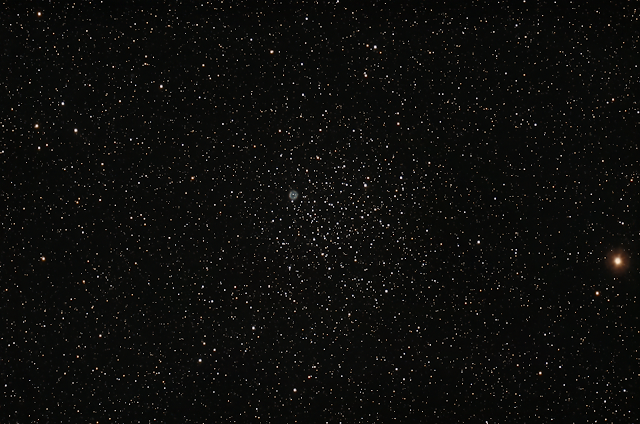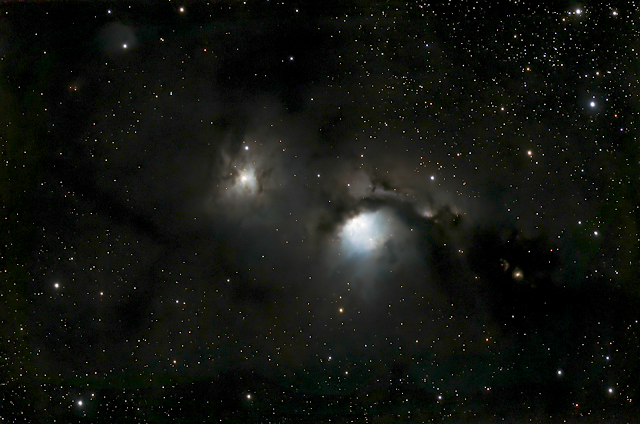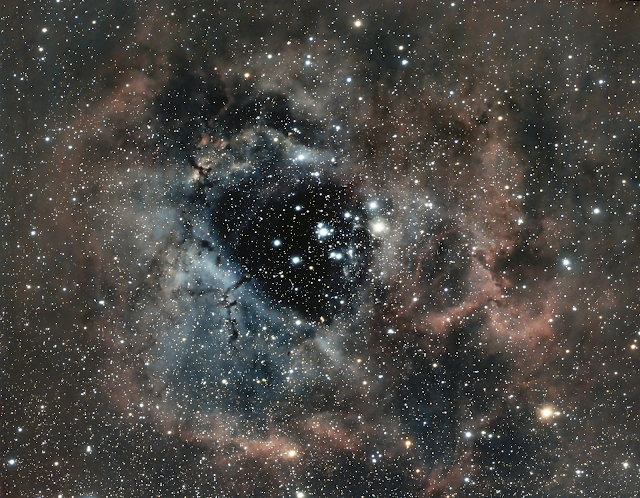After taking a look at galaxies and then nebulae, it is time now to see some of the star clusters that I have photographed in the last few months with my Celestron Origin telescope.
I'll start off with the closest of the bunch, the wonderful Pleiades (also known as The Seven Sisters and Messier 45):
At at distance of just over 400 light years, the Pleiades is the second closest star cluster to Earth. It is easily seen in the night sky and is a part of many sky myths from across the globe. The cluster looks good the the unaided eye, as well as through binoculars and telescopes.It is an open star cluster. Open clusters typically have a few hundred to a few thousand stars.
In addition to the many stars seen here, there is also a prominent reflection nebula--essentially dust that is illuminated by the light of the stars in the cluster. When I was a kid it was widely thought that the dust was left over from the formation of the cluster, but now we know that it is unrelated to it.
The cluster's apparent diameter is too large for me to capture all of it in a single image, so I will return to build a mosaic hopefully later this year.
The open star cluster known as Messier 46 is ten times farther away than the Pleiades:
This cluster also features an added treat. Just on the left edge of the cluster is a small planetary nebula. Like the dust in the Pleiades it is unrelated to the cluster itself, but makes for an added bonus when observing in this part of the sky.
Further out is the famous Double Cluster in Perseus:
The two clusters are NGC 866 (at top) and NGC 884 (lower middle) lie some 7,500 light years from Earth.At a distance of just 6,000 light years, Messier 4 in Scorpius is clearly an all together different type of star cluster:
It is a globular star cluster. These clusters contain hundreds of thousands of stars. Many of these clusters are the remnant cores of small galaxies that have been/are being consumed by our Milky Way galaxy.Messier 4 can be easily seen with binoculars just west of the red supergiant star Antares, in the heart of Scorpius.
Further out lies Messier 13, the Great Globular Cluster in Hercules:
Messier 13 is about 22,000 light years from Earth. M13 is the finest globular star cluster in the northern sky. The Southern Hemisphere has some finer ones, but they are too far south for me to be able to photograph them.Also in this image (near the lower left) is NGC 6207, a spiral galaxy located some 30 million light years from our Milky Way galaxy.
Finally, here's another globular star cluster, though it is so far away it hardly even looks like one.
NGC 2419 is sometimes called the Intergalactic Wanderer, though it does indeed orbit the center of the Milky Way galaxy. It is located 275,000 light years from Earth. That puts is 12.5 times farther away than M13!
It has been unusually cloudy of late, but I will be posting more astrophotos in the near future.






















